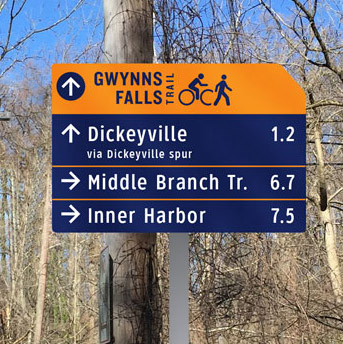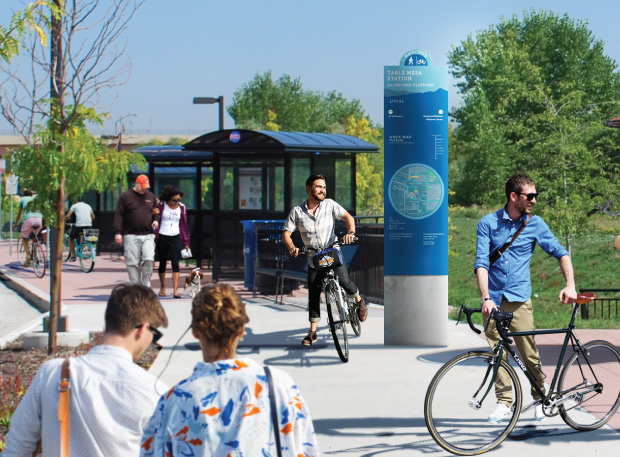Wayfinding on 2 wheels: in brief
More and more people are choosing bikes for transportation, communting and recreation. With more new users come more questions: which way should I go? is it safe? where does this lead? Good bicycle signage is crucial to cyclists feeling well-oriented and confident while riding, whether in the street or on a trail.
CG designs bicycle sign systems with a holistic, user-centered approach: we study the routes and connections, suggest changes to nomenclature, and design solutions that are practical, functional, and impactful. The signage also contributes an appealing and distinctive identity to the trail, raising its profile and importance.
A complete and thoughtful design process can deliver the following benefits to a bicycle signage program:
Articulate the bicycle network
Effective bicycle systems create a cohesive network, rather than disconnected individual trails and routes. This network is best unified and promoted through branded signage and maps which help cyclists locate a connected network and move through it with confidence. Signage is not just beneficial to cyclists: by physically marking a trail or thruway, vehicles and pedestrians also become aware of bicycle traffic, creating a safer environment for everyone.
In cities and towns, roads with bike lanes are often disconnected and routes are incomplete. Signage can connect these disjointed pieces so cyclists understand the safest routes to their destinations. Signage should highlight the best routes across a city and to popular areas—using bike lanes when possible, but suggesting lower-stress, lower-traffic roads when a bike lane is not available. When we develop our wayfinding strategy, we not only look at bicycle infrastructure, but also assess reports from transportation consultants and bicycle advocacy groups, “stress” ratings of roads, traffic density, and vehicle speeds.
Establish a placebrand
Bicycle signage is an excellent opportunity for placebranding—creating an identity for a physical space. Whether a regional bike route, an urban bicycle boulevard, or paved loop in a park, cohesive branded signage can elevate both the place and the user experience. We have extensive experience in creating an environmental identity through signage. We assist stakeholders in articulating their vision and communication goals. We then create solutions that can be applied to signage, digital media, and marketing materials.
Create signs that are legible and long-lasting
We combine branding with human factors and unique system requirements to inform the design of the signs. Information is clearly organized to communicate quickly and effectively, as most users will only have a few seconds to read each sign. We consider scale and placement appropriate for the viewing distance and speed of the rider. For regional routes shared with vehicles, signs must be scaled up for higher cycling speeds and larger setbacks. Our process also includes studying contrast, legibility, and lighting conditions when selecting colors, fonts and symbols.
We are also highly conscious and considerate of budget, lifespan and maintenance. Every project has unique requirements for longevity, durability, changeability, and cost. Phasing plans are often developed so signage can be deployed incrementally.
Clarify transitions and connections
Bike trails and on-street networks often have unusual connections, discreet entrances, and/or confusing intersections. Signage helps people find the trail and and stay on-route.
Bike trails should have obvious wayfinding signage, not just on the trail but integrated with on-street signage leading to and from the trail. This helps people access trailheads from their homes, work, school, or transit stations. Signage may also highlight connections to other regional bike trails – valuable information for long-distance and touring riders.
Communicate regulations and amenities
GPS programs often lack information important to cyclists —restrooms, water fountains, public transit stations, bike lockers, picnic tables and public parking lots. Maps created specifically for cyclists showing these amenities will encourage more frequent cycling.
In addition, on linear bike trails, simplified maps can make cyclists aware of exits to main roads, intersections with other trails and local points of interest. This can help cyclists plan their breaks and explore new areas.
Make bike travel inviting
One of the major benefits of bicycle signage is that it can encourage people to bike more. Just having a destination and mileage listed on a sign (for example, to a neighborhood, commercial district, sports venue, school or park) gives cyclists an understanding of where they can go. This is especially important for new cyclists who are unfamiliar with bike-friendly streets, and may be more timid than experienced cyclists. Distances not only orient cyclists, but allow them to gauge how far they can go before it gets dark.








